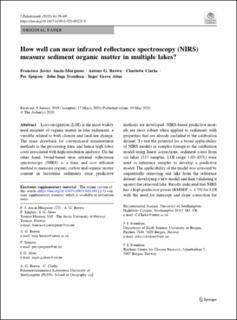| dc.contributor.author | Ancin Murguzur, Francisco Javier | |
| dc.contributor.author | Brown, Antony | |
| dc.contributor.author | Clarke, Charlotte | |
| dc.contributor.author | Sjøgren, Per Johan E | |
| dc.contributor.author | Svendsen, John-Inge | |
| dc.contributor.author | Alsos, Inger Greve | |
| dc.date.accessioned | 2021-05-20T07:59:11Z | |
| dc.date.available | 2021-05-20T07:59:11Z | |
| dc.date.created | 2020-07-24T13:10:32Z | |
| dc.date.issued | 2020 | |
| dc.Published | Journal of Paleolimnology. 2020, 64 (2), 59-69. | |
| dc.identifier.issn | 0921-2728 | |
| dc.identifier.uri | https://hdl.handle.net/11250/2755781 | |
| dc.description.abstract | Loss-on-ignition (LOI) is the most widely used measure of organic matter in lake sediments, a variable related to both climate and land-use change. The main drawback for conventional measurement methods is the processing time and hence high labor costs associated with high-resolution analyses. On the other hand, broad-based near infrared reflectance spectroscopy (NIRS) is a time and cost efficient method to measure organic carbon and organic matter content in lacustrine sediments once predictive methods are developed. NIRS-based predictive models are most robust when applied to sediments with properties that are already included in the calibration dataset. To test the potential for a broad applicability of NIRS models in samples foreign to the calibration model using linear corrections, sediment cores from six lakes (537 samples, LOI range 1.03–85%) were used as reference samples to develop a predictive model. The applicability of the model was assessed by sequentially removing one lake from the reference dataset, developing a new model and then validating it against the removed lake. Results indicated that NIRS has a high predictive power (RMSEP < 4.79) for LOI with the need for intercept and slope correction for new cores measured by NIRS. For studies involving many samples, NIRS is a cost and time-efficient method to estimate LOI on a range of lake sediments with only linear bias adjustments for different records. | en_US |
| dc.language.iso | eng | en_US |
| dc.publisher | Springer | en_US |
| dc.rights | Navngivelse 4.0 Internasjonal | * |
| dc.rights.uri | http://creativecommons.org/licenses/by/4.0/deed.no | * |
| dc.title | How well can near infrared reflectance spectroscopy (NIRS) measure sediment organic matter in multiple lakes? | en_US |
| dc.type | Journal article | en_US |
| dc.type | Peer reviewed | en_US |
| dc.description.version | publishedVersion | en_US |
| dc.rights.holder | Copyright The Author(s) 2020 | en_US |
| cristin.ispublished | true | |
| cristin.fulltext | original | |
| cristin.qualitycode | 1 | |
| dc.identifier.doi | 10.1007/s10933-020-00121-5 | |
| dc.identifier.cristin | 1820434 | |
| dc.source.journal | Journal of Paleolimnology | en_US |
| dc.source.40 | 64 | |
| dc.source.14 | 2 | |
| dc.source.pagenumber | 59-69 | en_US |
| dc.relation.project | Norges forskningsråd: 250963/F20 | en_US |
| dc.relation.project | Norges forskningsråd: 250963 | en_US |
| dc.relation.project | Norges forskningsråd: 255415 | en_US |
| dc.identifier.citation | Journal of Paleolimnology. 2020, 64, 59-69. | en_US |
| dc.source.volume | 64 | en_US |

